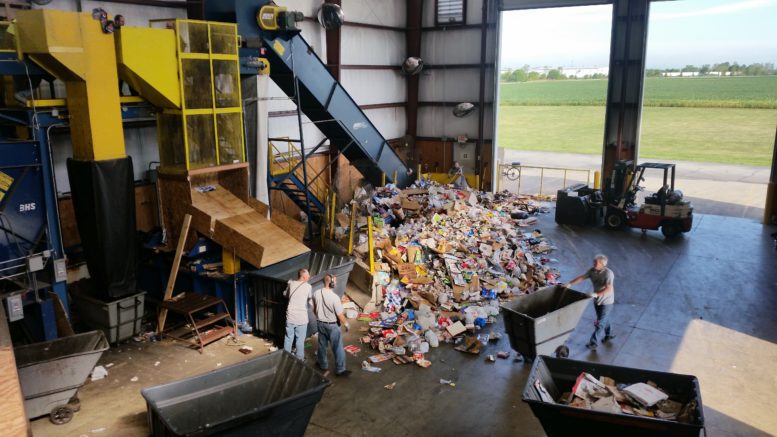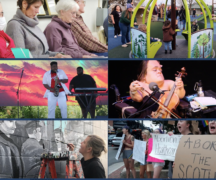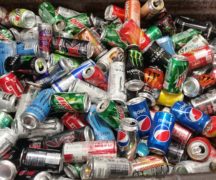By JAN LARSON McLAUGHLIN
BG Independent News
Ken Rieman is accustomed to handling some pretty disgusting stuff. But lately, his job is enough to test even the toughest of stomachs.
Last week, as he sorted through items at the Bowling Green Recycling Center, he came across raw hamburger squirming with maggots, dirty diapers and used feminine hygiene products.
In the past, the amount of trash placed in residential recycling bins has averaged anywhere from 7 to 18 percent. But in the last couple weeks, that amount has jumped up to 35 percent.
“That’s totally insane. We can’t handle that,” Rieman said. “That’s what I call abusing the system.”
Rieman thinks he knows the reason behind the increase. He believes it’s an unintended consequence of the city’s new trash bin rules. He suspects the city requiring garbage bin lids to be closed is leading people with overflowing trash bins to sneak their extra garbage into their recycling bins.
“The only explanation I have is the city trash rules,” he said. “They’ve said the lid has to be closed, so where does the trash go now?”
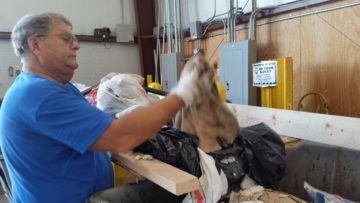
Ken Rieman pulls a filthy towel out of bagged “recyclables.”
On Friday, he stood at the Bowling Green Recycling Center, hand sorting items from bags that city residents had placed in their recycling bins. He sifted through cigarette butts, a filthy towel, footstool, used kitty litter, disc brakes, a broken scooter and rocks.
“Anyone who thinks I ought to be sorting for recyclables is welcome to take my job,” Rieman said.
But Bowling Green Public Works Director Brian Craft isn’t jumping to any conclusions that the new trash rules are causing the problem.
“Trash in recycling has always been a problem,” particularly at the beginning of every fall semester as Bowling Green State University students return, Craft said. Every August and September, city workers visit neighborhoods near campus to educate students about trash and recycling rules.
And this year may require even more education with the city’s new trash rules in place. The worst problems are occurring on Wednesdays, when the recyclables are picked up on the east side of Main Street, where most of the student population lives.
“There are always people who won’t follow the rules,” Craft said. “You’ve got to give us a chance to educate people.”
Since the recycling bins are dumped into city trucks with an automated arm, there is no way for workers to see trash in the containers. “There’s really not a whole lot we can do,” besides try to educate residents, Craft said.
As Rieman picked through the trash with thick gloves on last week, he pulled out papers showing violators’ addresses to turn over to the city to contact the offenders.
“We’ve got to get a handle on this. It’s a matter of do it right or don’t do it at all,” he said.
Rieman isn’t opposed to the new regulations that require trash bin lids to be closed. He just thinks the city needs to offer options for citizens who have too much trash. In some cases, residents could talk with their neighbors and ask if they could use the empty space in their trash bins.
“I think people can find a solution – but it’s also the city’s responsibility,” Rieman said. “I think they need to provide a solution for the extra trash, and it needs to be immediate.” It can’t be that residents have to store their trash for a week till they have more space in their bins.
“The objective is to take out the trash. If we’re not taking out the trash, did we make things better?” he said. “Let’s find a way to make this work.”
Rieman agreed that trash in recyclables has always been an issue. He has learned over the years that there are four basic types of recyclers.
There are the uninformed recyclers, who often put items in plastic bags to recycle. That leaves the crews at the recycling center with two options – neither good – hand-sorting through the bags or throwing the bags out all together.
There are the wishful recyclers, who think almost anything can be recycled. One of those probably threw the Lite-Brite game in the bin last week. “These people think anything plastic is recyclable,” Rieman said.
There are the abusers, who regularly throw “flat out trash” in their recycling bins.
Then there are Rieman’s favorites, the dedicated recyclers, many who bring their items to the drop-off site at the center. The 24-hour drop-off area gets less than 1 percent trash. “That’s recycling,” he said.
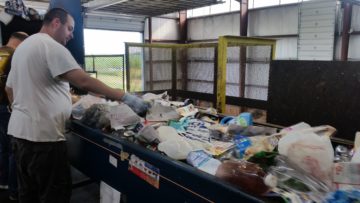
Jamie Babcock, of Community Employment Services, sorts through recyclables mixed with trash.
The problem with trash in with the recycling isn’t just that someone has to sort through it. The trash clogs up the system, contaminates some of the recyclables, and creates risks for workers.
“In order to ship this stuff to our buyers, we have to get the trash out,” Rieman said.
Though the paper and cardboard recycling industry tends to be more forgiving since it is turned into insulation, the plastic recycling industry is much more particular about purity.
Then there’s the delays the trash creates, not only by requiring more hand-sorting, but also by clogging up the chutes at the recycling center.
“We’ll be lucky to finish today,” Rieman said last Friday as the recycling lines kept getting plugged and shutting down. “We are running super slow.”
Mayor Dick Edwards believes the problem will be lessened as the 30-day education period on the new trash bin rules continues.
“That would be really unfortunate if people are dumping garbage in recycling bins,” Edwards said. But he is confident the issue will improve.
“Don’t hit the panic button yet,” the mayor said.
Rieman agreed that the 35 percent garbage in recyclables can drop if city residents are better informed.
“We think there’s hope – if we can get people to do it right,” he said.
Items accepted in curbside recycling are:
- Cardboard/paper, including corrugated cardboard, dry-food boxes, paper bags, egg cartons, clean dry newspapers, magazines and catalogs, phone books, all colors of office paper, mail and greeting cards. No shredded paper.
- Plastic containers, such as milk jugs, detergent or shampoo bottles, plastic pop or water bottles, plastic jars. Empty, flatten and put lids back on.
- Metal, such as aluminum beverage cans, drained and flattened; steel cans, rinsed clean with lid inside
- No glass. Glass can be taken to the drop-off site but at curbside it often results in broken glass and safety issues for workers .

